How PR Firms Benefit from Using The PESO Model in Podcasting
As a public relations professional, you have a deceptively simple goal: grow your client’s business. But to do this for your client, you need to wear many hats at the same time. You perform their media relations, content marketing, strategy development, and more.
Usually, you need to use different channels to achieve all of these goals, but today we’re here to show you that podcasts can help with all your PR goals at the same time. And not only that, by adopting the PESO model of PR, your podcast PR efforts don’t only grow individually, but holistically.
In this article, we’ll overview the PESO model and how to execute it with podcasts.
Table of Contents:
- What is the PESO model?
- Owned Media
- Shared Media
- Earned Media
- Paid Media
- Conclusion – Learn More About Podcasts and PR
What is the PESO model?
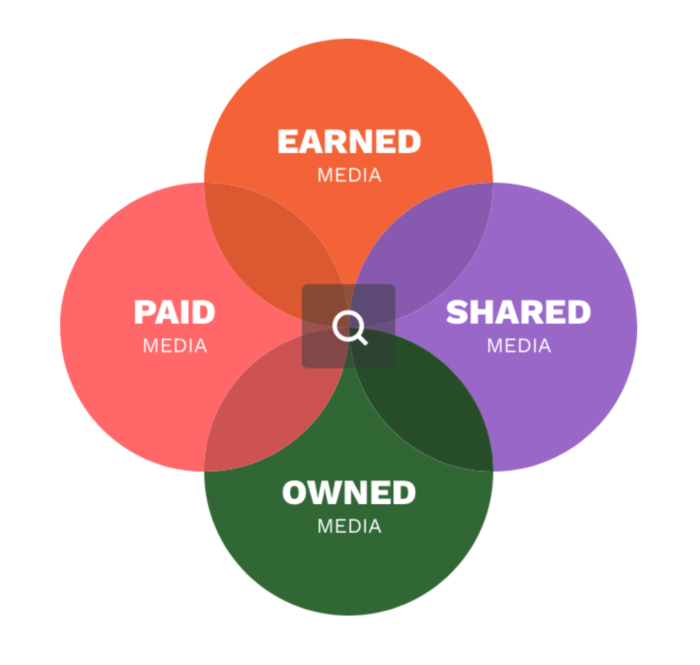
PESO is a PR strategy invented by Gini Dietrich, the founder and CEO of Spin Sucks. PESO is an acronym for Paid Media, Earned Media, Shared Media, Owned Media.
Here’s what each of those mean:
- Paid media: Media that is purchased, such as advertising, sponsorships, and paid social media posts.
- Earned media: Media that is earned through media relations efforts, such as earned media placements, interviews, and press releases.
- Shared media: Media that is shared by others, such as user-generated content, social media posts, and influencer marketing.
- Owned media: Media that is owned by the organization, such as the organization’s website, blog, and social media channels.
PESO doesn’t simply mean performing each of these media types, but integrating them as one overlapping strategy. When done correctly, each subset of PESO feeds into each other, creating a PR snowball effect that grows overtime.
How to Use Podcasting In Your PESO Campaign
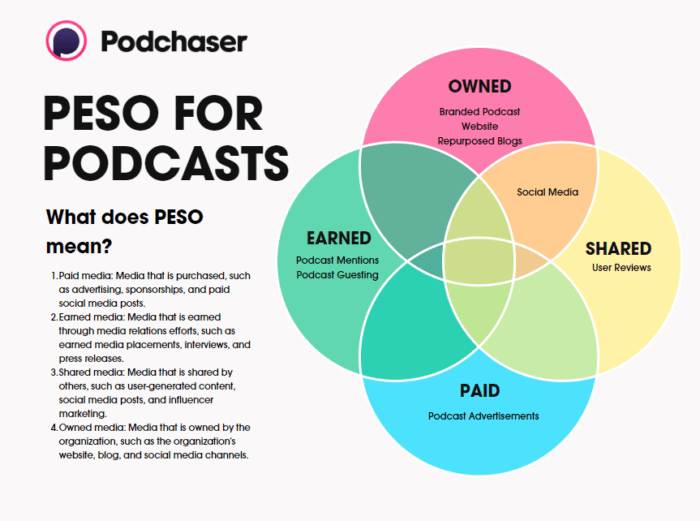
Owned Media:
While the PESO acronym starts with “P”, your campaign should always start with “O”: owned media. All your owned media needs to be set before you can benefit from paid, earned, and shared media.
In this section, we’ll discuss the various owned media channels you’ll combine with podcasting.
Branded Podcast
Branded podcasts are podcasts owned and produced by a specific brand. Beyond that, branded podcasts can be anything. Some are interview podcasts, others storytelling podcasts, and some are even serialized dramas. Branded podcasts provide creative freedom, allowing your client to tell their story in whatever method is most effective for them.
Branded podcasts are the backbone of your PESO podcast campaign, as it’s the one direct podcasting channel you have control over. In addition, the content you create on your show can be repurposed as paid media and shared media.
Blog Posts
Blogs are an important form of owned media, no matter the campaign. They create another avenue of discovery via Google search, which is where the vast majority of the planet goes to find new information.
And thanks to your branded podcast, blog posts won’t take nearly as much work. Your client has already done the hard work by researching and recording their episode. Now all that’s left is to transform the content into an article.
The most direct way to accomplish this is by publishing a transcript of the episode on your client’s website, but we don’t recommend this. Instead, take the transcript and polish it into a SEO rich blog post. Unique insights from the blog also become an avenue for earned media, as other outlets can quote and link back to your blog posts
Website
Your website is where you host all your owned content, like blogs, social media, and podcasts. It is also where you can showcase your earned media and shared media, like articles, social mentions, podcast guest appearances, and podcast reviews.
In this day and age making a website is incredibly easy. There are myriad tools to help you register a domain name and design a beautiful website in less than half an hour.
Social Media
Social media is where you promote your owned media, and where you establish a brand presence – hopefully creating enough buzz to inspire shared media and earned media.
Also, social media is also a great place to network to find guests for your branded podcast, or establish connections with influencers who will book your client as a guest on their show.
To accomplish both of these goals, it’s important to create quality social media content. Oftentimes, companies post on social media because they know they should, but they don’t put the time and effort in to creatively curate their feeds. Experiment with your social posts and keep track of what types of posts are resonating the most with your audience.
Shared Media
Shared media is synonymous with social media. It’s digital word-of-mouth marketing. With your owned media, you’ve already created content for people to talk about, so now the next step is to get them talking about it.
A difficulty with shared media is how little control you have over it. You can’t force people to authentically talk about your podcast related owned media. The only thing you have control over is the quality of your owned media. If it’s amazing, people will naturally share it with their friends and family. If it’s mediocre, listeners will move on to a different podcast without ever uttering a peep on social media.
Social Media
While you can’t directly create shared media, you can definitely inspire your following to start conversations via social media.
Through your owned channels, you’ve already created the content for people to share, now you need to post it on social media in a way that entices your followers to share with their audiences.
Here are two social media methods to get people talking:
1) Engage with Fans
At a basic level, you can use social media to alert followers of new podcast episodes, but your social media feed shouldn’t be purely announcements.
You should engage with your clients’ podcast fans by posting questions or enticing pictures related to your content. By supporting the fanbase, you’re creating evangelists for their shows. The more audiences like what you post and create, the more likely they will share the podcast via word of mouth on social media.
2) Expose Your Show to New Audiences
To expose your branded podcast to a new audience on social media, you’ll have to participate in other people’s posts. You should involve yourselves in conversations about topics the podcast covers, but be authentic and don’t over promote your show.
The key to increasing your social footprint is to create posts with the intent of receiving likes, shares, and retweets. Some practical tips are to ask questions, share insightful articles, and promote other podcasts and platforms. Here’s the social media’s open secret: every company wants to promote posts that make them look good.
So if you want a platform to post about your branded podcast, tag them in a tweet that links to their platform only. If you link to their platform and their competitor in the same post, neither one will want to share for fear of promoting their competition.
Podcast Reviews
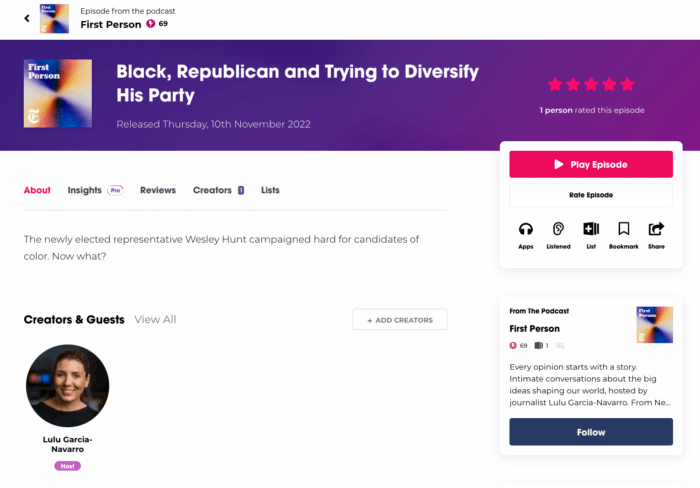
Podcast reviews are the only shared media exclusive to podcasts. Many podcast listeners find new shows by reading podcast reviews, and it’s easy to understand why. Positive podcast reviews provide social validation for the quality of the podcast, so if you have many positive reviews, your show will naturally gain listeners.
As an example, even if listeners don’t know anything about Lulu Garcia Navarro, they are immediately more likely to listen to her podcasts because her most recent appearances are a wall of well-reviewed episodes.
Here’s two must-do’s to accrue positive listener reviews:
1) Submit Your Podcast Everywhere (Especially Podchaser)
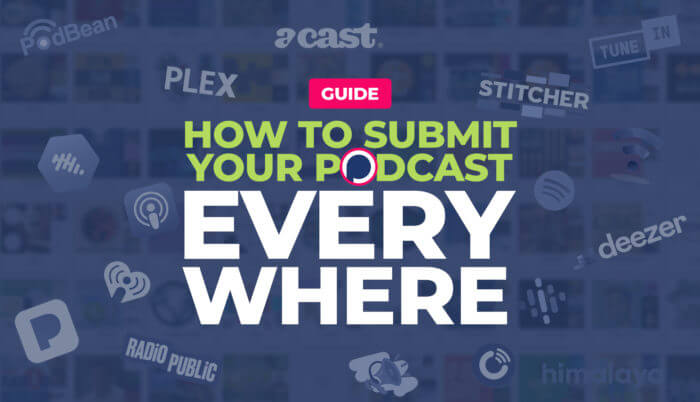
To get shared media through user reviews, your podcast needs to be available wherever listeners review podcasts. That means you need to submit your podcast to as many podcast directories as possible.
There are dozens of podcast directories. We’ve written a whole article explaining how to add your podcast to every podcatcher. I know that sounds like a lot, but don’t fret. The process generally only involves uploading your RSS feed.
If you’re in a time crunch, there are two main places you need to register. Many podcatchers take their directories from Apple Podcasts, so if you submit your show to Apple Podcasts, it will upload to several other podcatchers at the same time.
The second is Podchaser. It’s likely that we already have your podcast in the database, but if not, you can add your podcast to Podchaser here. Once your podcast is on Podchaser, promote it even further by claiming your podcast.
2) Simply Ask for Reviews
Sometimes to get shared media, you need to ask for shared media. There’s no shame in asking for what you want. If you’ve grown a dedicated audience for your podcast, they’ll be happy to support your show in whatever way you ask them to.
For many years, My Brother My Brother and Me hosts the McElroy brothers asked their listeners to review and promote them, specifically stating that they relied entirely on word of mouth to grow their podcast. Now the McElroy’s have a few books, a series of graphic novels, a TV show, and several successful podcasts.
Earned Media
Earned media is similar to shared media in that you can’t directly control it, but you can facilitate its creation through specific methods. Where shared media is about word of mouth promotion from the average consumer, earned media is about getting influential people and organizations to share your message.
Earned media in podcasting means two things:
- Pitching podcasts to share your message on their show
- Booking your client as a podcast guest
Pitching Podcasts To Share Your Message on Their Show
The secret about podcasts is that creators are hungry for interesting content to share on their shows. They’ve been talking about the same subject for years, and have already discussed all the easy topics. If you have an intriguing piece of information, product, or service, you can ask podcasters to discuss it on their show, and they might even say yes!
When targeting podcasts to pitch to, find shows that are perfectly aligned in topic to your client’s business. For instance, if your client’s startup makes innovative plant-based paints, find podcasts that discuss sustainability and unique innovations.
Consistently providing quality content for a podcast builds trust, where they might mention your client’s brand or product naturally over time. And if the podcast host especially is interested in something you share with them, you can suggest that your client comes on as a guest to provide further context.
Booking Your Client as a Podcast Guest
At Podchaser we are huge evangelists of podcast guesting and all of its promotional benefits. Guesting on other podcasts provides an in-depth way to share a message with minimal work, while also providing free traffic to your client’s website and social platforms.
As I alluded to earlier, we’ve written a lot about podcast guesting, so we don’t want to rehash everything in this article.
If you want to learn everything there is to know about podcast guesting, check out these other Podchaser articles.
- 6 Benefits of Being a Podcast Guest
- How to be a Guest on a Podcast – 8 Steps to Get You Booked
- Find Podcasts To Be a Guest On
- How to Find Podcasts Looking for Guests
- Podcast Guest Etiquette, According to the Experts
- How to Get The Most Out of a Podcast Guest Appearance
And if all that seems like too much work, try Podchaser Connect, our full-service podcast guest placement service. Skip the hard work and let our team of experts handle discovery, pitching, follow-ups, and scheduling.
Paid Media
Paid media in podcasting mostly boils down to buying advertisements on podcasts. Not only can podcast advertisements increase sales and traffic to your owned media, but they can also boost your earned and shared media by building brand awareness. Let’s get into it.
Podcast advertising is a huge industry – its spend is predicted to sail past $6 billion in 2026. And it’s easy to see why advertisers spend more on podcasts every year. Every month an average of 104 million Americans listen to podcasts, up from 67 million in 2017. That’s one third of the country! Roughly the same number of Americans who watch football every week.
In addition, 45% of podcast listeners make at least $75,000 per year, meaning that podcast listeners tend to have a high discretionary income. Which they love to use on podcast advertisements, with more than half of listeners reporting that they’ve made a purchase from a podcast advertiser.
And to top it all off, podcast ads are really cheap, especially compared to syndicated radio or television. We’ve written a whole article diving deep into podcast ad rates, but the short version is that they cost $10-30 per one thousand listeners. A similar 30-second radio ad can cost hundreds of dollars, depending on the market.
Finding Perfect Podcasts to Advertise On
While we’ve shown that podcasts aren’t a niche medium, they are a medium that thrives on niches. Part of the podcasting’s success is that listeners can find shows discussing just about anything, from pens, to The Beatles, to cricket. So no matter what your client’s product or service is, there are podcasts that are the perfect fit for you to advertise on.
The trouble is actually finding those perfect podcasts. Podcast listening apps are a nightmare to search for potential advertising partners, and once you find topically related podcasts, it’s nearly impossible to find out how many listeners a podcast has…unless you have Podchaser Pro.
Podchaser Pro provides everything you need to be successful with your advertising campaign. Search the world’s most comprehensive database for podcasts you’re interested in, and then browse our one-of-a-kind statistics before you decide to reach out. Not only can we tell you how many listeners a podcast has, but also a history of what companies have sponsored the podcasts in the past, their contact information, demographic data, and more.
Learn More About Podchaser Pro
Conclusion – Learn More About Podcasts and PR
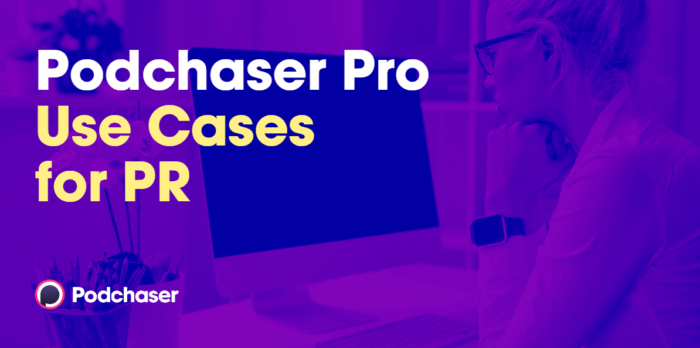
While you can pick and choose to focus on any of these types of media for your clients we recommend dabbling in everything, because the beauty of the PESO model is how everything feeds into each other.
Your owned and paid media create earned media and shared media. Then you can repurpose your shared and earned media mentions back into owned and paid media, adding social validation to your controlled channels. The PESO model is a self propelling promotional machine fed by today’s content consumption habits.
As we’ve highlighted throughout this article, Podchaser Pro is your all-in-one intel platform for your podcasting needs. Read our full article about the 3 ways PR firms can utilize Podchaser Pro.
Unlock more with Podchaser Pro
- Audience Insights
- Contact Information
- Demographics
- Charts
- Sponsor History
- and More!

- Account
- Register
- Log In
- Find Friends
- Resources
- Help Center
- Blog
- API
Podchaser is the ultimate destination for podcast data, search, and discovery. Learn More
- © 2024 Podchaser, Inc.
- Privacy Policy
- Terms of Service
- Contact Us